Wildlife photography captures the beauty of nature while highlighting its cultural significance. This art form involves understanding animal behaviour, using specialised equipment, and mastering composition techniques. It plays a vital role in conservation efforts and supports local communities through ecotourism. Aspiring photographers face challenges but can enhance their skills through practice and knowledge of wildlife.
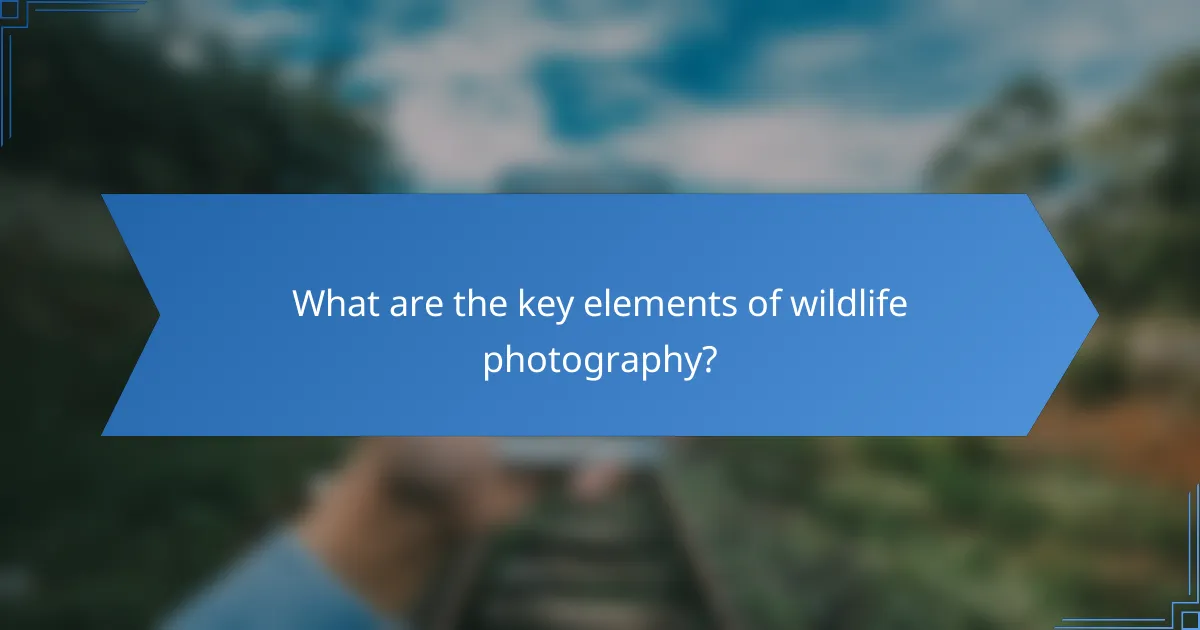
What are the key elements of wildlife photography?
Key elements of wildlife photography include understanding animal behaviour, using appropriate equipment, mastering composition, and respecting wildlife. These aspects enhance the quality of images while ensuring ethical practices.
Understanding animal behaviour allows photographers to anticipate actions and capture compelling moments. Appropriate equipment, such as telephoto lenses, ensures clear images from a distance. Mastering composition techniques enhances visual storytelling. Respecting wildlife promotes conservation and minimises disturbance.
How does composition impact wildlife photography?
Composition significantly impacts wildlife photography by influencing the visual narrative and emotional engagement. Effective composition guides the viewer’s eye and emphasises the subject, enhancing storytelling. Techniques like the rule of thirds and leading lines create dynamic images that capture attention. Unique attributes, such as the subject’s environment and behaviour, can further enrich the composition, making each photograph distinct. As a result, thoughtful composition elevates wildlife photography from mere documentation to an artistic expression of nature’s beauty.
Why is lighting crucial in wildlife photography?
Lighting is crucial in wildlife photography because it enhances the subject’s features and mood. Proper lighting reveals textures, colours, and details that can make an image compelling. Natural light, especially during golden hours, creates dynamic shadows and highlights, adding depth. Additionally, the direction of light affects how animals are perceived, influencing the emotional impact of the photograph. Understanding lighting conditions can significantly improve the quality of wildlife images, making them more engaging for viewers.
Which camera settings are ideal for capturing wildlife?
To capture wildlife effectively, use a fast shutter speed, wide aperture, and appropriate ISO settings. These settings minimise motion blur, enhance focus, and adapt to varying light conditions.
1. Shutter Speed: Use at least 1/1000 second to freeze action.
2. Aperture: Set between f/2.8 and f/5.6 for sharp focus and good light intake.
3. ISO: Adjust between 400 and 1600 based on lighting; higher in low light.
4. Focus Mode: Use continuous autofocus to track moving subjects.
5. Exposure Compensation: Adjust to prevent overexposure in bright conditions.
These settings help achieve clear, dynamic images of wildlife in their natural habitats.
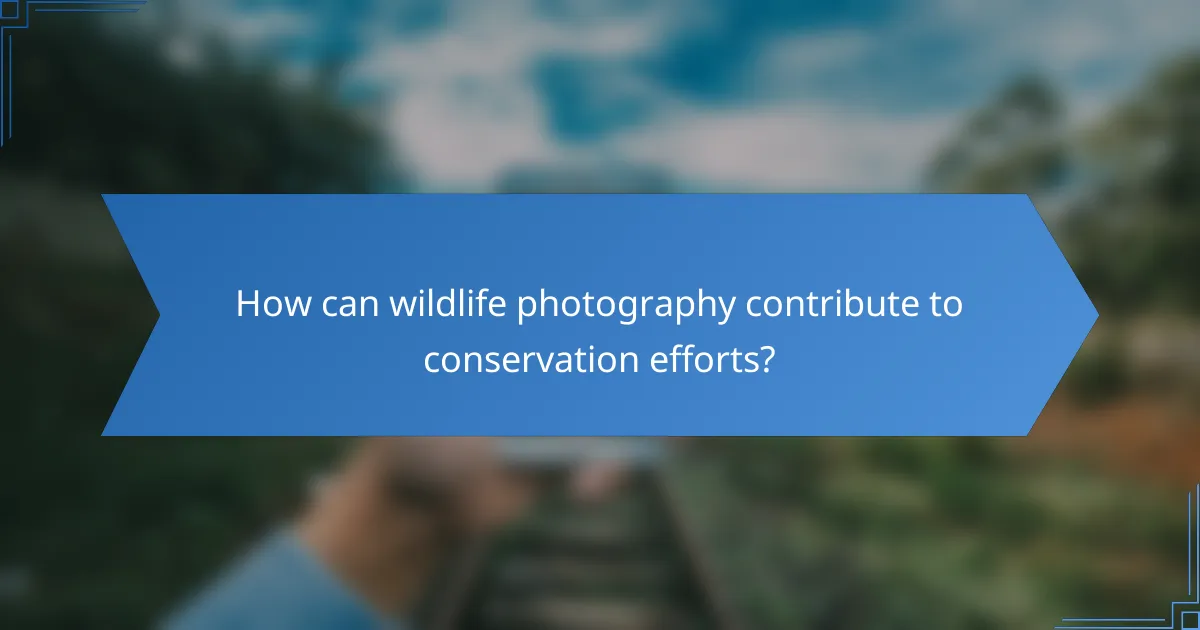
How can wildlife photography contribute to conservation efforts?
Wildlife photography significantly contributes to conservation efforts by raising awareness and promoting environmental protection. Through compelling imagery, photographers can highlight the beauty and fragility of ecosystems, motivating public engagement and support for conservation initiatives.
Additionally, wildlife photography often serves as a tool for scientific research, documenting species and habitats that require protection. This visual documentation can influence policy decisions and funding for conservation projects. By showcasing the impact of human activity on wildlife, photographers can foster a sense of urgency and responsibility among viewers.
Moreover, wildlife photography can support local communities by promoting ecotourism, which generates revenue while encouraging sustainable practices. This economic incentive can lead to better conservation outcomes, as communities recognise the value of preserving their natural resources.
In summary, wildlife photography plays a crucial role in conservation by inspiring activism, supporting research, and fostering sustainable economic practices.
What role does storytelling play in wildlife photography?
Storytelling is essential in wildlife photography as it conveys the emotional and cultural significance of nature. Through compelling narratives, photographers can highlight conservation issues and the beauty of ecosystems. This approach fosters a deeper connection between viewers and wildlife, encouraging empathy and action. Unique attributes of storytelling in this context include the ability to capture fleeting moments that reveal animal behaviour and habitat interactions. As a result, storytelling transforms mere images into powerful messages that resonate with audiences.
How can photographers raise awareness through their work?
Photographers can raise awareness through wildlife photography by showcasing the beauty and fragility of nature. This art form highlights endangered species and their habitats, prompting discussions on conservation. Engaging storytelling through images can evoke emotional responses, encouraging audiences to support environmental initiatives. Additionally, collaborating with conservation organisations amplifies the message, reaching broader audiences and fostering community involvement.
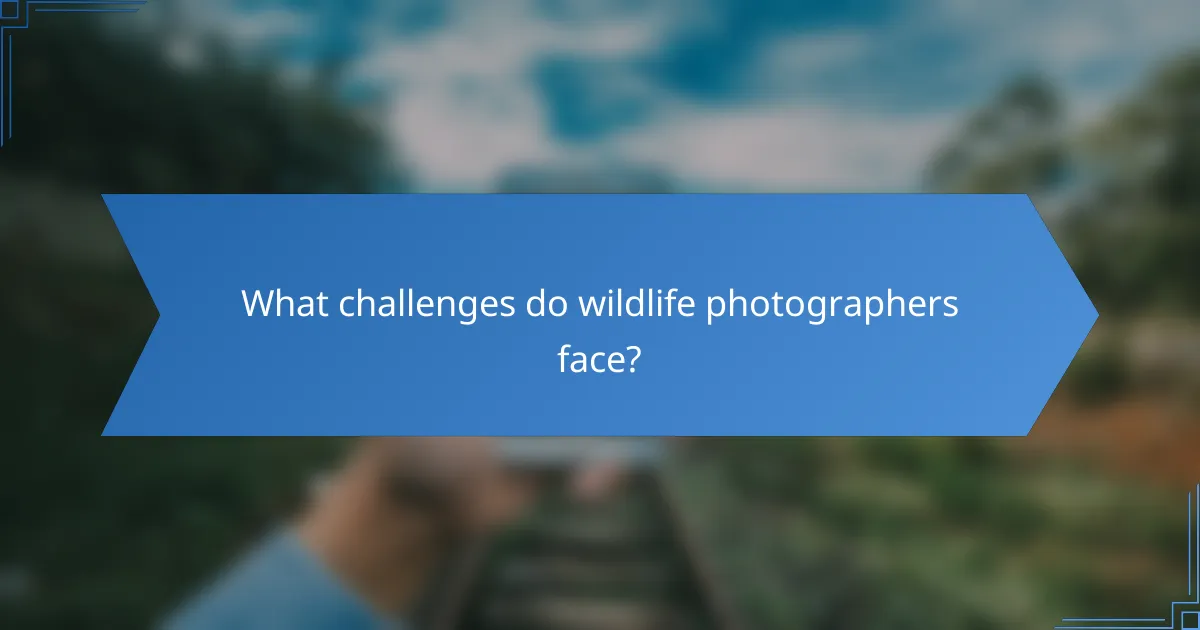
What challenges do wildlife photographers face?
Wildlife photographers face numerous challenges that impact their work. These include unpredictable weather conditions, which can hinder shooting opportunities. Accessing remote locations often requires physical endurance and logistical planning. Wildlife behaviour is another significant challenge; animals can be elusive, making it difficult to capture desired moments. Ethical considerations also play a role, as photographers must respect animal habitats while striving for impactful images. Additionally, the need for specialised equipment can create financial barriers for aspiring photographers.
How does weather affect wildlife photography?
Weather significantly impacts wildlife photography by affecting animal behaviour, lighting conditions, and overall scene aesthetics. Different weather patterns create unique opportunities for capturing diverse wildlife activities. For instance, overcast skies enhance colours and reduce harsh shadows, while golden hour light during sunrise or sunset creates dramatic effects. Rain can lead to increased animal movement as they seek shelter, providing unexpected photographic moments. Understanding these dynamics allows photographers to plan effectively and adapt to changing conditions, maximising their chances of capturing compelling images.
What are the ethical considerations in wildlife photography?
Ethical considerations in wildlife photography include respecting animal habitats, minimising disturbance, and ensuring responsible representation. Photographers should avoid exploiting wildlife for profit. They must prioritise conservation, adhere to regulations, and promote awareness of ecological issues. Responsible practices enhance the integrity of wildlife photography and contribute to cultural significance.
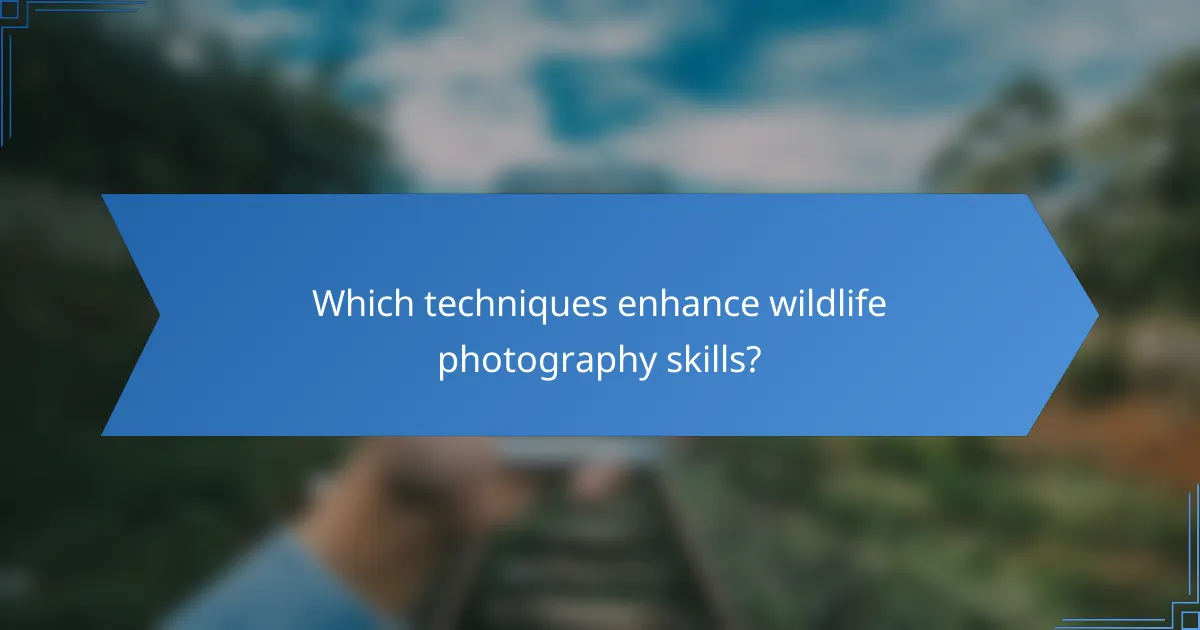
Which techniques enhance wildlife photography skills?
To enhance wildlife photography skills, practice techniques such as patience, understanding animal behaviour, and mastering camera settings. These approaches improve the quality of images captured in natural settings.
Key techniques include:
1. Researching wildlife habits to anticipate movements.
2. Using natural light for better exposure and mood.
3. Employing a telephoto lens for close-up shots without disturbing animals.
4. Practicing stealth to avoid scaring subjects.
5. Experimenting with different angles to find unique perspectives.
6. Continuously reviewing and analysing past work for improvement.
How can photographers improve their fieldcraft?
Photographers can improve their fieldcraft by practicing patience and observation. Mastering wildlife photography requires understanding animal behaviour, which enhances the chances of capturing compelling images.
Utilising the right equipment, such as telephoto lenses, allows for better distance shots without disturbing wildlife. Additionally, learning to use natural light effectively can significantly improve image quality.
Engaging in continuous education, whether through workshops or online courses, can provide new techniques and insights. Networking with other photographers can also inspire creativity and offer valuable feedback.
Lastly, spending time in various environments helps photographers adapt to different conditions, enhancing their overall skill set.
What post-processing techniques are effective for wildlife images?
Effective post-processing techniques for wildlife images include adjusting contrast, enhancing colours, sharpening details, and noise reduction. These techniques improve image quality and highlight the beauty of wildlife.
Contrast adjustment enhances the dynamic range, making the subjects stand out. Colour enhancement brings vibrancy to the image, capturing the essence of the environment. Sharpening details ensures that textures and features are clear, while noise reduction eliminates unwanted grain, especially in low-light conditions.
Using these techniques can significantly elevate the impact of wildlife photography, allowing for a more engaging viewer experience.
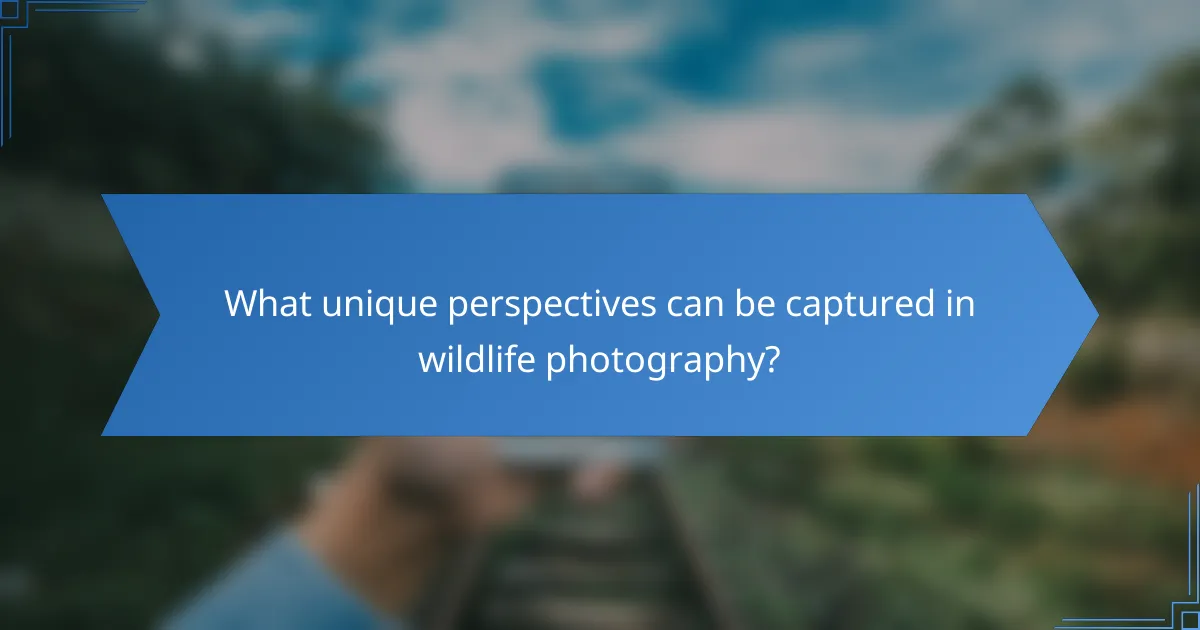
What unique perspectives can be captured in wildlife photography?
Wildlife photography offers unique perspectives that showcase the beauty of nature and highlight cultural significance. Photographers capture intimate moments of animal behaviour, revealing insights into their lives. This art form also emphasises conservation efforts, raising awareness about endangered species and their habitats. Additionally, it can document the relationship between humans and wildlife, illustrating cultural practices and beliefs tied to nature. These perspectives enrich our understanding of biodiversity and inspire action to protect it.
How does cultural context influence wildlife photography?
Cultural context significantly influences wildlife photography by shaping the photographer’s perspective and approach. Cultural beliefs, values, and narratives inform how wildlife is perceived and represented. For instance, indigenous cultures often emphasise harmony with nature, leading to more respectful and authentic portrayals of wildlife. In contrast, Western perspectives may focus on conservation or exploitation, affecting the aesthetic and emotional tone of the photographs.
Moreover, cultural context can dictate the choice of subjects and settings in wildlife photography. Photographers may prioritise species that hold cultural significance or are emblematic of specific regions. This choice enhances the storytelling aspect of the images, connecting viewers to broader cultural narratives.
Additionally, cultural context influences audience interpretation. Viewers from different backgrounds may derive varied meanings from the same photograph based on their cultural frames. This diversity enriches the discourse surrounding wildlife photography, encouraging deeper engagement with the subject matter.
Ultimately, understanding cultural context allows photographers to create more meaningful work that resonates with diverse audiences while promoting awareness of wildlife conservation.
Which rare species have been notably documented in wildlife photography?
Rare species notably documented in wildlife photography include the Amur leopard, Sumatran orangutan, and Vaquita. These species are critically endangered, making their visual documentation vital for conservation awareness. Wildlife photographers often capture their unique behaviours and habitats, emphasising their rarity. For example, the Amur leopard, with fewer than 100 individuals left, showcases the importance of habitat preservation efforts.
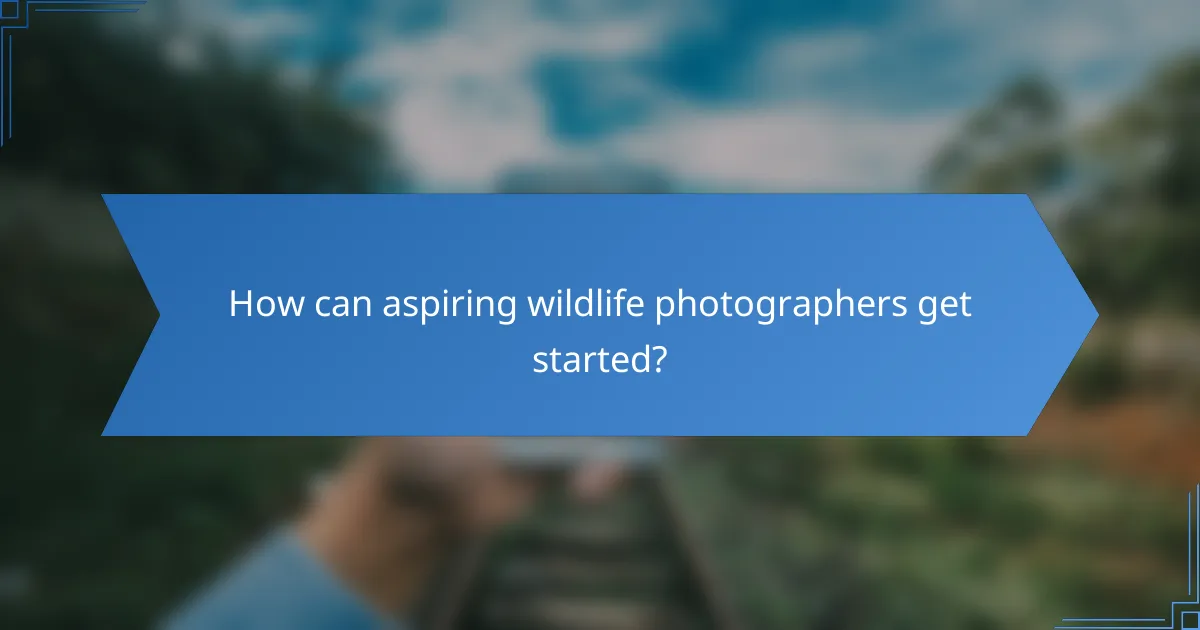
How can aspiring wildlife photographers get started?
Aspiring wildlife photographers can start by investing in quality equipment and learning essential techniques. Begin with a camera that suits your budget and skill level. Understand the basics of exposure, composition, and lighting. Research wildlife behaviour to anticipate animal movements. Practice patience and spend time in various habitats to capture diverse species. Join online communities for feedback and inspiration. Consider workshops or courses to enhance your skills. Building a portfolio will help showcase your work and attract potential clients or publications.
What essential gear is needed for wildlife photography?
Essential gear for wildlife photography includes a high-quality camera, versatile lenses, sturdy tripod, and weather protection. A camera with fast autofocus and high ISO performance is crucial for capturing fast-moving subjects. Telephoto lenses help in getting close to wildlife without disturbing them. A tripod ensures stability, especially in low light conditions. Weather protection safeguards equipment from the elements.
Which resources provide valuable insights for beginners?
Beginner wildlife photographers can gain valuable insights from various resources. Online courses, such as those offered by platforms like Udemy or Coursera, provide structured learning. Photography blogs and YouTube channels, like Nature TTL or The Wildlife Photographer, offer tips and tutorials tailored to beginners. Additionally, social media groups and forums, such as Facebook groups dedicated to wildlife photography, foster community support and feedback. Books focused on wildlife photography techniques, like “Wildlife Photography: A Beginner’s Guide,” can serve as comprehensive references.
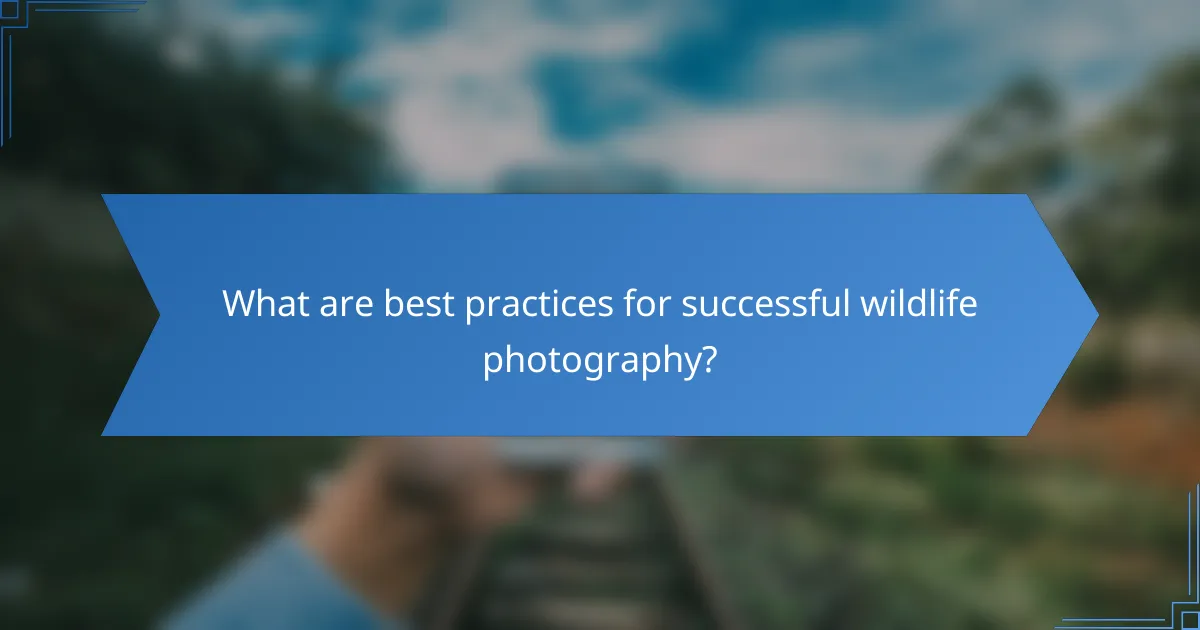
What are best practices for successful wildlife photography?
To achieve successful wildlife photography, focus on patience, knowledge of animal behaviour, and technical skills. Understanding the habitat and timing is crucial for capturing compelling images.
1. Research the species and their behaviours to anticipate movements.
2. Use appropriate equipment, such as a telephoto lens, for distance shots.
3. Practice ethical photography by minimising disturbance to wildlife.
4. Be patient and ready; great shots often require waiting for the right moment.
5. Experiment with different lighting conditions for varied effects.
How can photographers ensure they are respectful to wildlife?
Photographers can ensure they are respectful to wildlife by following ethical guidelines and best practices. They should maintain a safe distance to avoid disturbing animals and their habitats. Using telephoto lenses allows for capturing images without intruding. Understanding animal behaviour helps anticipate reactions, preventing stress. Photographers should avoid flash photography, which can startle wildlife. Lastly, adhering to local regulations and respecting protected areas promotes conservation efforts.
What common mistakes should be avoided in wildlife photography?
To enhance wildlife photography, avoid common mistakes that can detract from capturing powerful images. Failing to research subjects leads to missed opportunities for unique shots. Neglecting proper equipment can result in poor image quality. Inadequate understanding of lighting conditions may cause unflattering photos. Lastly, rushing the process often results in missed moments and unplanned compositions.
How can collaboration with local communities enhance wildlife photography?
Collaboration with local communities enhances wildlife photography by providing unique insights and access to diverse environments. Engaging with locals fosters trust and encourages the sharing of cultural narratives that enrich the storytelling aspect of photography. This partnership often leads to discovering rare wildlife behaviours and locations, enhancing the overall quality of the photographic work. Additionally, local knowledge can guide photographers to capture images that resonate with both nature and cultural significance, creating a deeper connection to the subject matter.